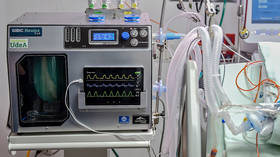Iron lung for 2: Researchers develop ventilator-sharing model which could turn the tide on Covid-19 deaths

Researchers have developed a theoretical model which could allow for one ventilator to be shared by two patients, relieving pressure on ICU departments in hospitals the world over as they fight the Covid-19 pandemic.
Early in 2020, as the coronavirus pandemic swept across the world, several governments panicked at the prospect that there might not be enough ventilators for Covid-19 patients in intensive care units.
Also on rt.com ‘Very poorly equipped’: UK facing dire scarcity of ventilators as Covid-19 cases increase, says largest manufacturerNow, scientists from King's College London and Imperial College London claim to have developed a theoretical means by which two patients could safely share a ventilator, thanks to risk-mitigation factors like variable resistances and one-way valves.
As severely ill patients require individualized pressure and airflow volumes, unique to each person and their specific circumstances, the volume given to each patient would need to be independently controlled to keep them stable.
According to the new research, published in Royal Society Open Science, the proposed system would work in much the same way as an electrical circuit. It would include variable resistors and one-way valves added into the inhalation and exhalation paths of the ventilator circuit for each patient.
Furthermore, the joint team believes the system could one day have far-reaching implications for emergency medicine outside of the current pandemic.
“Beyond the Covid-19 pandemic, the approach could potentially be useful in a range of other extreme scenarios, such as coping with acute disaster surge capacity limitations or in a military battle field context,” said the study’s co-author Dr Peter Vincent, of Imperial's Department of Aeronautics.
Also on rt.com Resistance loses it as Trump offers extra US ventilators to RUSSIA to help with Covid-19They caution, however, that their modified ventilator splitter should only be considered in the most extreme circumstances as a “last resort.”
The team is now seeking feedback from the international medical and scientific community prior to pre-human trials to test the proof of design.
However, their peers may not be quick to endorse the long-touted, but never tested, idea.
Earlier this year, a group of respiratory and critical care organizations signed a joint statement warning against the attempted sharing of ventilators with current equipment.
They cited a high mortality rate of 40‐60 percent in best-case scenarios treating acute respiratory distress syndrome patients, claiming that, given the high number of uncertainties that still remain about Covid-19, the mortality could be increased if ventilators were shared.
“It is better to purpose the ventilator to the patient most likely to benefit than fail to prevent, or even cause, the demise of multiple patients,” they said.
Think your friends would be interested? Share this story!













